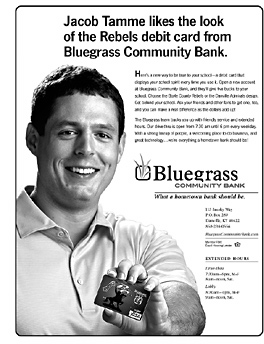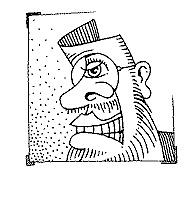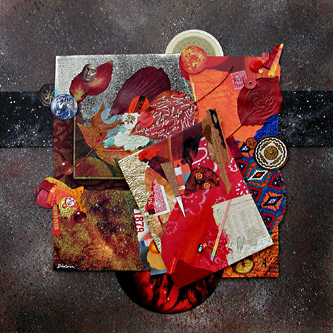“There is no substantial difference by which we can attribute a higher aesthetic value to one choice or the other. Our preference is a question of a personal, irrepressible urge.”
—Leo Lionni
D a n n y D
at a recording studio
somewhere in Lexington

After years of friendship built on untold hours of front porch discourse and coffee shop dialectic, Danny and I finally had the opportunity to work together on a creative project before his family’s chapter in Danville came to an end with the sale of their nearby house on West Broadway. However, it would be beneficial to back up and start my account at a more logical beginning:
The story begins at a typical sighting of our familiar Graybeard Prospector—a Chamber-sponsored networking event hosted by a newly organized bank. My pal David was in a conversation with the president of the bank when they looked my way and motioned me to join them. Within a few moments I was one of the first to learn about the imminent signing of a one-year endorsement contract with local football hero Jacob T, who had completed his NFL rookie year with the Colts after an accolade-studded career at UK. I gathered my wits as the short briefing came to a head. “We have to get a year’s worth of photographs and radio spots before he goes into training camp.”
A question flashed internally. “How would a true Ad Man reply?” With his stainless steel gaze fixed to observe my response, an imaginary Donald Draper was standing off to one side, a deftly balanced Lucky in hand. I heard myself say, “If I understand correctly, you need creative direction, and you need it fast.”
Before the impact registered, the project was in my lap and the countdown to Jacob’s departure had begun. The photo part almost felt easy. I had a solid list of pros in my head and the first one took the assignment when contacted. In a matter of days we were shooting Jacob at a personal appearance. On the other hand, it had been over a decade since Dana and I had produced any radio advertising. I felt rusty. Audio technology had moved to desktop digital since then, and there were other important factors, too. I knew the default setting would be to handle this at the hometown radio station, and my gut told me that I had to find a way to pull this into a slicker technical environment. I was confident our print advertising would look first-rate, but to stand apart on the radio would be a different kind of challenge.
The last thing I wanted was to generate “more of the same” junk so typical of local radio. If at all possible, I hoped to accomplish two things: a) create scripts that would promote the bank with words that rang true for Jacob’s personality, and b) grab the listener’s attention with music at the same level of production quality that motivated them to listen to the radio in the first place. Anything less might simply be brushed off as “some bank paying Jacob to read stuff on the air.” It made sense for me to consult someone who knew more than I did about this sort of thing. I needed to talk it over with Danny.
When I delicately raised these issues with him at the Hub one evening over a tall “haf-caf,” his response astonished me. Literally poking me in the shoulder, he mentally grabbed hold of my ideas and offered to write some music with lyrics that would help carry the campaign I envisioned. He gave me so much good advice that retaining barely a third of it enabled me to get a green light from the bank to book a recording studio and capture Danny’s work. He seemed delighted to do this favor for me, given the fact that he’d watched Jacob grow up and had a high regard for his family. I couldn’t believe my good fortune. Danny said all he wanted was to have the bank guys buy him a dinner, and I wasn’t sure whether he was joking about that part of it. I knew he was dead serious about the rest.
It took some digging, but I tracked down a sound pro named Kevin J that I’d met through Eric C in the 90s. He was the best in Lexington at the time, and, more importantly, he was worthy of my total trust. Our session together with Danny came off with flying colors and I walked out the door with everything I’d hoped for. It was exactly what I needed for the type of spots I wanted to produce. Kevin and I mixed a disc of various musical tracks at :60, :30, and :15 lengths. Now all I had to do was close the deal by winning the bank’s approval to combine Danny’s distinctive sound with Jacob’s natural voice.
Ideally suited to Jacob’s character and reputation, there was something powerfully authentic about Danny’s original words and music. Dana and I made a supreme effort to pitch those tracks to the CEO, but he fundamentally could not envision the effectiveness of my concept— to contrast a relaxed, down-home style against the typically phony-sounding chatter on the radio.
When I told Kevin that the head of the bank had thrown out Danny’s music as an element of the radio advertising, he didn’t seem surprised. Although understanding and supporting the approach I’d proposed, the experienced audio engineer and producer observed, “John, I have known people who tried to combine art with advertising, but it is rarely possible to convince the buyer. Clients have a tendency to play it too safe, do what every other similar business is doing, and then wonder why it doesn’t work better.”
Having failed to sell my idea of making the music be an equal partner in the message, the success of the production would now depend entirely on Jacob’s vocal sincerity. I pushed for the same Lexington studio we’d used to record Danny, arguing that to merely bring Jacob to the local radio station where he’d interned as a student would work against our effort to enhance his self-image as a professional. Having him rise to the challenge of his first major voice-over gig was the only hope of capturing the genuine personality on which we could hang the campaign, and I also needed Kevin’s technical expertise to produce high-quality, finished spots.
The “homework” I’d done to ensure that Dana’s scripting would naturally sync with Jacob’s values paid off with a smooth, comfortable recording session. He praised her scripts. His gifted ability to focus on task, along with his easy-going confidence, sense of humor, and considerable breath control, left us all rather impressed. After getting the go-ahead to use some appropriate background music I discovered on the Web, Dana, Kevin, and I brought the project in on budget with seven :30 spots, two :15 spots, and the ingredients for yet-to-be-written, Jacob-introduced spots that could rely on adjunct voice talent.
Much to our surprise and disappointment, a recommended introductory newspaper ad with Jacob’s image was drastically reduced without our knowledge. It looked terrible when published and put us into the position of explaining why it was not only illegible but also quite ignorable. This took place after Jacob’s sports agent endorsed our work when he saw the preliminary design. Playing catch-up, I adjusted the photo density to compensate for the poor reproduction, and we encouraged the bank to enlarge the ad for two follow-up insertions. The third time around it was printed well enough to look respectable, even though it was still significantly smaller than what we’d suggested was required to create a sufficient level of impact for an effective campaign kick-off.
 Football season is getting under way and we anticipate a bigger splash to draw the market’s attention to our new client bank. So far, people “in the know” have made positive remarks to me, but I await the first clear indication that we’re putting something out there that is doing the job. Over 70 banks have already failed in the USA since January 1st. Clearly, this isn’t the most advantageous time to open a financial institution, but I like to think of our situation this way: Here’s an enterprising group that wasn’t forced to think outside the box because it was never inside the box. Time will tell if the innovations they’ve brought to Danville will meet with consumer satisfaction. Hey, if they hired me, they’re obviously not stuck in the status quo. Let’s hope some good things start to happen!
Football season is getting under way and we anticipate a bigger splash to draw the market’s attention to our new client bank. So far, people “in the know” have made positive remarks to me, but I await the first clear indication that we’re putting something out there that is doing the job. Over 70 banks have already failed in the USA since January 1st. Clearly, this isn’t the most advantageous time to open a financial institution, but I like to think of our situation this way: Here’s an enterprising group that wasn’t forced to think outside the box because it was never inside the box. Time will tell if the innovations they’ve brought to Danville will meet with consumer satisfaction. Hey, if they hired me, they’re obviously not stuck in the status quo. Let’s hope some good things start to happen!
So there’s my tale about how an exciting chance to compose a stand-out piece of promotion can turn into another missed opportunity. Nevertheless, we have an entire year to pull this campaign up a few notches, and our client has already expressed an interest in using the song Danny wrote for us to anchor some kind of Web video or podcast. To be honest, the main reason I put together this detailed account is so I can remember it myself as part of an unusually interesting summer. With everything going on, including the latest round of major abdominal surgery for Bruce, this e-log is undoubtedly the best memory chip I have going for me.


 Saddest of all is when I realized that the awe of star-gazing had slipped away, as my ability to perceive the dimensionality of the night heavens declined. The optimistic hope for improvement, given the functional plasticity of brain neurons, is emphasized by both Susan Barry, Dr. G., and Debra (my therapist). I accept that, in spite of having no comprehension of the difficulties that lie ahead, or how “one must learn to align the eyes and fuse their images, while unlearning the unconscious habit of suppressing vision, which has been occurring perhaps for decades,” or how therapy “requires high motivation and self-awareness, as well as enormous perseverance, practice, and determination.”
Saddest of all is when I realized that the awe of star-gazing had slipped away, as my ability to perceive the dimensionality of the night heavens declined. The optimistic hope for improvement, given the functional plasticity of brain neurons, is emphasized by both Susan Barry, Dr. G., and Debra (my therapist). I accept that, in spite of having no comprehension of the difficulties that lie ahead, or how “one must learn to align the eyes and fuse their images, while unlearning the unconscious habit of suppressing vision, which has been occurring perhaps for decades,” or how therapy “requires high motivation and self-awareness, as well as enormous perseverance, practice, and determination.”



